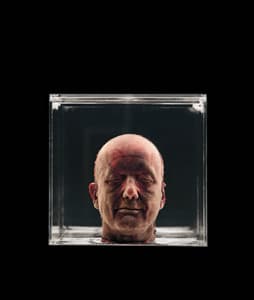
Body and the uncanny
At its most visceral, hyperrealist sculpture plays with the abject, the uncanny and the disturbing. In particular, self-portraiture and works which reveal the alter-ego of the artist are particularly and peculiarly arresting.
Every five years since 1991, Marc Quinn takes six litres of his blood and freezes it into a sculpture of his head. Self 2011 resembles a scientific specimen, contained within a sealed chamber and plugged into a refrigeration unit. As a sculpture formed from biological matter, it engages with the idea of cryogenics (specifically neuropreservation) in which the head is removed and frozen without the body. Quinn’s work represents a faith in medical technology, where, in time, it might provide the DNA required for a future cloning of the artist—a human life preserved and remade anew.
Ronnie van Hout has established an artistic practice around the doppelgänger or ‘double walker’. His figures often feature the artist’s own face, awkwardly morphed with a smaller body, to produce a 'manchild'. As repeated images Sitting figure I and II trigger our latent fears about the destruction of individualisation by the infinite replication of the human being. This represents a fear of parthenogenesis, of creation without fertilisation. The human being then, becomes just another object of mass production alongside contemporary consumer products, images and experiences.
Both Quinn and van Hout employ self-abasement to explore the abject: a human entity dependent on life-supporting technology, and a human in a constant state of replication. These works appear simultaneously alive and dead, real and artificial, familiar and strange, evoking an uneasy sense of the uncanny.





